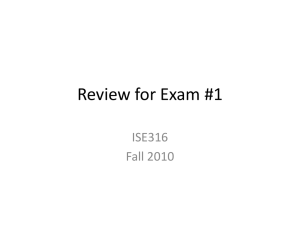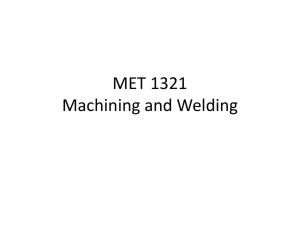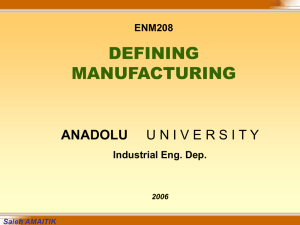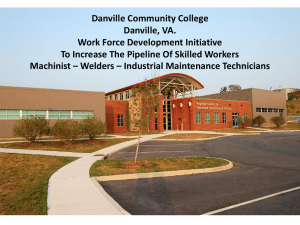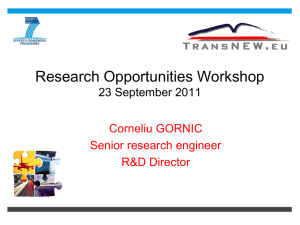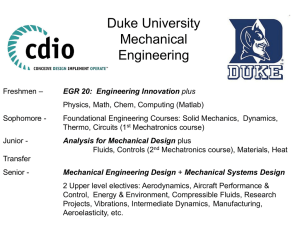ME 4182 Fall 08, section E
advertisement
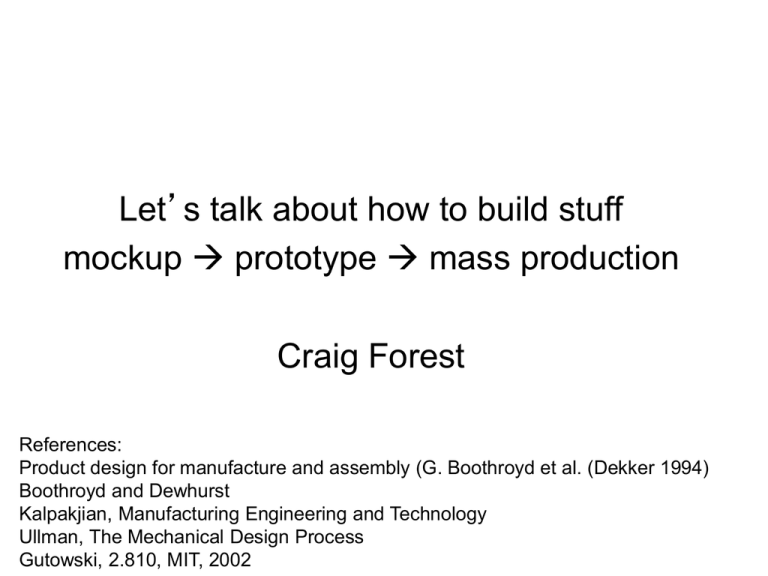
Let’s talk about how to build stuff mockup prototype mass production Craig Forest References: Product design for manufacture and assembly (G. Boothroyd et al. (Dekker 1994) Boothroyd and Dewhurst Kalpakjian, Manufacturing Engineering and Technology Ullman, The Mechanical Design Process Gutowski, 2.810, MIT, 2002 Prototype manufacturing processes • Metal – – – – – – – – – – – Band saw Drill press Mill Lathe Grinder Waterjet 3-D printing (laser sintering) Welding Casting Electrical discharge machining Sheet metal forming (shear, brake, corner press) • Polymers – – – – – – – – – – 3-D printing Injection molding Thermoforming Laser cutting Casting Band saw Drill press Mill Lathe Waterjet • Ceramics – Molded and bakes, sintered • Composites – Layups Prototype manufacturing processes • Metal – – – – – – – – – – – Band saw Drill press Machining Mill Lathe Grinder Waterjet 3-D printing (laser sintering) Welding Casting Electrical discharge machining Sheet metal forming (shear, brake, corner press) • Polymers – – – – – – – – – – 3-D printing Injection molding Thermoforming Laser cutting Casting Band saw Drill press Machining Mill Lathe Waterjet • Ceramics – Molded and bakes, sintered • Composites – Layups Waterjet http://web.mit.edu/2.972/www/reports/abrasive_water_jet/abrasive_waterjet.html http://en.wikipedia.org/wiki/Water_jet_cutter www..omax.com Laser cutting 100 µm laser spot size 200 µm hole diameter 75W CO2 laser Trotec Speedy 100 3D printing Layer by layer additive process http://home.att.net/~castleisland/sl.htm http://common.ziffdavisinternet.com/encyclopedia_images/_3DPCOLR.JPG http://www.archinect.com/schoolblog/entry.php?id=34570_0_39_0_C Electrical discharge machining Wire as small as 30 µm! MS Thesis MIT 2003, Tim Fofonoff http://www.engineersedge.com/edm.shtml Welding • Melt workpieces and add filler • Energy comes from gas flame, an electric arc, a laser, an electron beam, friction, and ultrasound Oxyacetylene ( 3100C ) -most common -cheap equipment http://en.wikipedia.org/wiki/Oxy-fuel_welding_and_cutting http://www.thenewchinkyworkshop.com/OxyAcetylene1.jpg Casting Machining http://www.efunda.com/processes/machining/machin_intro.cfm Design rules for machining Standardization 1. Utilize standard components as much as possible 2. Preshape the component, if appropriate, by casting, forging, welding, etc 3. Utilize standard pre-shaped workpieces if possible 4. Employ standard machined features whenever possible. Design rules for machining Raw Material 1. Choose raw material that results in minimum component cost (raw material + machining) 2. Utilize raw material in the standard forms supplied Component design for machining Generally 1. 2. 3. 4. Strive for machining using 1 machine tool Strive to minimizing fixturing Sufficient rigidity when fixtured for machining No interference between tool, toolholder, workpiece, fixture 5. Holes cylindrical, straight and with standard L/D for drilling or boring, normal to part axes 6. Blind holes conical, tapping blind hole considered Component design for machining Rotational components 1. Cylinders concentric, plane surfaces normal to axes 2. External diameters increase from outer face 3. Internal diameter decrease from outer face 4. For internal corners, use standard radii 5. Avoid intenal features for long components Component design for machining Non-rotational components 1. Provide base for fixturing/referencing 2. Prefer faces perpendicular/parallel to base 3. Use standard radii, large radii for internal features 4. Diameters decrease inside the part Accuracy and surface finish • Specify widest tolerances possible • Specify roughest surfaces possible • Avoid internal corners on low roughness surfaces Sheet metal forming shearing bending drawing • Name 5 sheet metal formed parts • What materials are used • What can go wrong when sheet metal forming? Sheet metal forming Sheet metal forming Sheet metal forming Sheet metal forming shearing F 0.7TL(UTS) T sheet thickness F 0.7TL(UTS) T sheet thickness L = total length sheared UTS = ultimate tensile strength L = total length sheared UTS = ultimate tensile strength of the material bending WT 2 F (UTS) L W width bent T sheet thickness L = length bent Design rules • Outer profile with parallel edges defining part width • Angles > 15˚ Features a-e >2x thickness Relief cutout Design rules >2h >4h >2h Design rules Minimize waste Let’s talk about assembly $$$$ • Assembly costs are 25-50% of mfg costs • % workers doing assembly is 20-60% This is a big $$$ deal!!! History lesson • 1st complex assembly mfg tasks – Muskets in 1700’s • Interchangeable parts in early 1800’s John Hall’s breech design demonstrated interchangeability at Harper’s Ferry in 1827 Complex products required more assembly >1,000 parts >10,000 parts The Pratt & Whitney F100 military engine powered the F-15 and the F-16. Credits - Credit to Pratt & Whitney: A United Technologies Company >100,000 parts Airbus A380 for 853 people Assembly lineHenry Ford Trained workers put together the flywheel magneto ignition system for the Model T - 1913 The old fashioned way - limousines are assembled at individual stations by a Pittsburg manufacturer, 1912 End of the Line. The Model T's body is joined to its chassis at the Highland Park plant Requirements • Work design (balance steps, ergonomics) • Design for assembly • Interchangeable parts Assembly types • Manual 1. Handling • • • Automated – High-speed automated assembly – Robotic assembly Pickup Orient 2. Insertion • • • Location Hold down and resistance Securing method Design for Manual Assembly Rules 1. 2. 3. 4. 5. 6. 7. 8. Reduce part count and part types Strive to eliminate adjustments Design parts to be self-aligning and self-locating Ensure adequate access and unrestricted vision Ensure the ease of handling of parts from bulk Minimize the need for reorientations during assembly Design parts that cannot be installed incorrectly Maximize part symmetry if possible or make parts obviously asymmetrical 8. Maximize part symmetry if possible or make parts obviously asymmetrical Additional features that affect part handling Insertion issues Insertion issues Insertion issues Insertion issues Design for high-speed automated assembly • Automatic part handling – Be easily separated from bulk – Be easily conveyed along the track of a vibratory or hopper feeder – Be readily oriented in high speed feeding device • Automatic insertion – Avoid need to reorient during assembly – Parts not secured immediately on insertion are fully located – Easily aligned (e.g., leads lips, tapers chamfers) – Layered fashion assembly from above – Avoid high insertion forces Design for robotic assembly Design for service • Repair (you will be doing this a lot) – Elements most likely to need service located at outer layers of the product Design for disassembly • • • • • • • Reduce # of components Reduce # of separate fasteners Provide open access and visibility for separation points Avoid orientation changes during disassembly Avoid non-rigid parts Use common tools and equipment Design for ease of handling and cleaning of all components • Reduce number of different materials • Enable simultaneous separation and disassembly • Facilitate the sorting of non-compatible materials What are the reasons for having 2 separate parts in a design? What are the reasons for having 2 separate parts in a design? 1. Does the part move relative to all other parts already assembled? 2. Must the part be of a different material? 3. Assembly/Dissassembly? Assembly of injection molded parts • Press fit – Takes advantage of loose tolerances of molded parts • Riveting/staking – Heated form tool melts part locally • Ultrasonic welding • Snap fits Impact of good DFA Some products are still difficult to make with interchangeable parts Grinding capability 0.001 10 4 10 0.001 10 4 10 Aerospace requirement 0.003 10 5 25 12 Thermal expansion L LT 25 12 13 10 6 2 0.01



